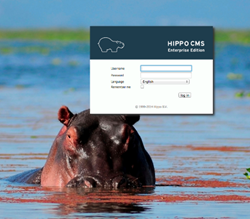Hippo CMS Goes On Demand
How many web content management/digital experience vendors offer some type of cloud-version of their CMS? Not many. You could always install the Hippo CMS in the cloud, but now the vendor is providing a self-service PaaS version that it believes “is poised to revolutionize customer experience delivery.”
 Okay, so we can forgive Hippo for its excitement and we can certainly understand what a PaaS version of a CMS can do for an organization. Hippo’s original cloud-version was IaaS, where it provided the ability to run Hippo in the cloud on various cloud-based infrastructures. According to Hippo, this first version of its cloud-based offering made up 50% of new business in the past 18 months. Hippo says it choose to develop the new version of Hippo CMS as a cloud-first PaaS version because it believed it could provide a faster and easier experience for its customers. Hippo also feels other options in the industry aren’t as agile.
Okay, so we can forgive Hippo for its excitement and we can certainly understand what a PaaS version of a CMS can do for an organization. Hippo’s original cloud-version was IaaS, where it provided the ability to run Hippo in the cloud on various cloud-based infrastructures. According to Hippo, this first version of its cloud-based offering made up 50% of new business in the past 18 months. Hippo says it choose to develop the new version of Hippo CMS as a cloud-first PaaS version because it believed it could provide a faster and easier experience for its customers. Hippo also feels other options in the industry aren’t as agile.
This is true to some extent, especially when you are dealing with mid-range SaaS services or huge suite-based platforms, but there are plenty of cloud-based CMS offerings that are agile and provide companies the ability to support great customer experiences.
What’s in Hippo OnDemand
Hippo OnDemand, which they also refer to as the DX Cloud on their website, is built on Amazon AWS and Docker technology. It provides the ability to set up and manage different environments from Development to Test and User Acceptance and finally Production.
Its REST API-driven micro services architecture enables companies to develop the applications and websites they need on the Hippo platform and integrate easily with other business systems as well as third-party applications - a must have for any CMS provider today.
If your company is global, Hippo has included a few multilingual enhancements focused on localizing the UI and supporting global collaboration on the admin side.
Hippo also made improvements to its personalization engine. Previously, it leveraged third party tool for its relevance mode. Now it includes a native relevance store. This provides a couple of things – lower costs because you don’t have to deal with third-party licenses and maintenance, and you don’t have to procure, implement, and train users on this additional tool.
Self-Service PaaS
Platform-as-a-Service (PaaS) means that you have complete access to a cloud environment - servers and software - to develop, manage and run your applications. It’s not just about putting up a simple website and users of Hippo do much more than simple websites. Hippo is a platform upon which you can create websites or web applications. So if they wanted to provide a robust cloud option to customers, PaaS is really the only choice.
Hippo onDemand provides a control panel where developers can monitor and manage their stacks, roll out new instances, manage backups and request additional resources.
I asked Hippo how its support model works for Hippo onDemand. They told me that they support the PaaS components as well as the Hippo platform itself, including performance aspects, hotfixes, security patches and so on. But when it comes to supporting the actual implementation specifics, support falls under a different model which is typically provided by either Hippo Professional Services or the customer’s implementation partner.
Mobile, Social, and Cloud
You're maybe thinking if you hear these three terms again, you’ll be sick. We’ve certainly spent plenty of time talking about how important it is for organizations to have mobile experiences, be present and active in social media and look to the cloud for alternatives to on-premises applications, but it is more than just words.
The pressure to constantly and consistently keep in step with customer demands requires an agility that on-premises software and infrastructures can’t always provide. You want your teams focused on the business and on delivering value to customers. IT is one of these teams. If they are regularly locked down into ensuring a technical environment is up and running, always using the latest versions of software, which no longer come out every couple of years, but every couple of months, and performing routine tasks, how can they help the business leverage the software the way they need to?
Companies can take the money that would have been spent on infrastructure and support and put it into the development of applications and experiences, while ensured that their PaaS provider is taking care of the details on the technical delivery side.
Not every company is ready for self-service PaaS, but for those that are, and are looking for a new CMS/DX provider, Hippo is one to check out. And for those that are still sticking with on-premises, Hippo told me that there are no plans in the ‘foreseeable future’ to stop offering its on-premises version and all the functional and platform improvements that go into Hippo onDemand, will be rolled into the on-premises version. Oh, and that IaaS version of Hippo onDemand? That is no longer offered going forward.

Barb Mosher Zinck
Barb Mosher Zinck is a content marketer, marketing technology analyst. She spends her days learning how to build better customer experiences through content, translating what she’s learned into actionable strategies for her clients and practical guidance for her magazine audience.